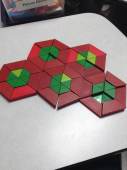Chinese mathematics started to emerge in the 11oo BCE. They discovered many important topics including negative numbers, decimals, and trigonometry. It is difficult however to find information prior to 254 BCE, but the limited information we have will be where we start our journey through Chinese mathematics.
We first look at the Shang Dynasty and the Yi Jing. This book influenced later work in the Zhou Dynasty. The Yi Jing, or the I Ching, showed the uses of the hexagram in mathematics and contains one of the first uses of binary numbers. The book also showed that the Chinese had a basic understanding of equations and negative numbers. After the Shang Dynast, the Zhou Dynasty showed the importance of mathematics in society. This is best presented in the idea that math was one of the Six Arts that students were required to perfect. The perfect Chinese student that learned the Six Arts could be equivocated to the Renaissance Man in western Europe.
Even though math was seen as important during the Zhou Dynasty, we see a backwards slide during the Qin Dynasty. This is because Emperor Qin killed academics in droves because he wanted to change the cultural dynamics of the country to one of subservient peasants; however, one mathematical idea that left the Qin Dynasty was the standardization of weights, which allowed for easier trade. Furthermore, there is evidence that the Chinese understood advance formulas for volume and proportions because of the architectural wonders produced during this time.
Math makes a comeback during the Han Dynasty. This is best seen in the way of the discovery of putting numbers into a place value decimal system. Furthermore, they had a concept of the number zero in the form of leaving a blank in the counting board to mean zero. Finally, Zhang Heng gave the most accurate approximation of pi up to that point in Chinese history.
The final dynasty we will look at is the Tang Dynasty. This is because by the Tang Dynasty rolled around mathematics was a standard subject; so much so that the use of The Ten Computational Canons was used regularly. This was a collection of mathematical works put together by Li Chunfeng and was used as the official textbook for the imperial examination. Another important thing was that the cubic equation appeared for the first time with Jigu Suanjing. Finally, they had a practical understanding of plane trigonometry with regards to the sine, tangent, and secant values.
As we can see, mathematics flourished in China without the help of the western powers. It can even be said that it was developed independently from the Europeans. This is significant because the American education system only looks at the development of mathematics from an eurocentric perspective instead of a global perspective. This just shows that a global perspective is necessary to completely understand mathematics.

